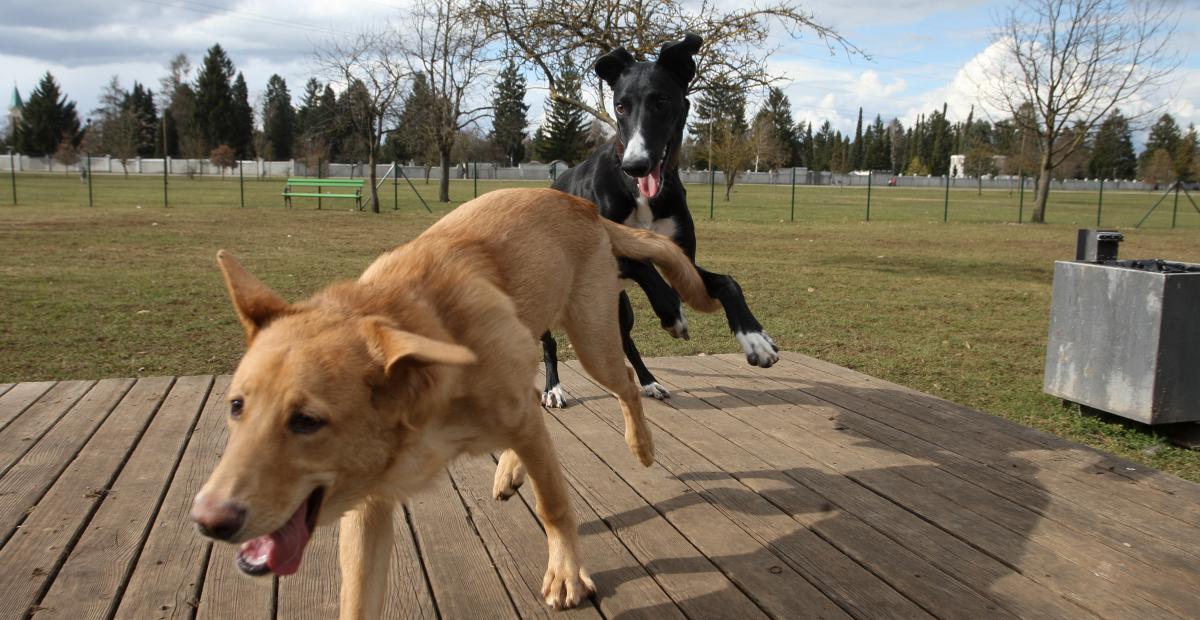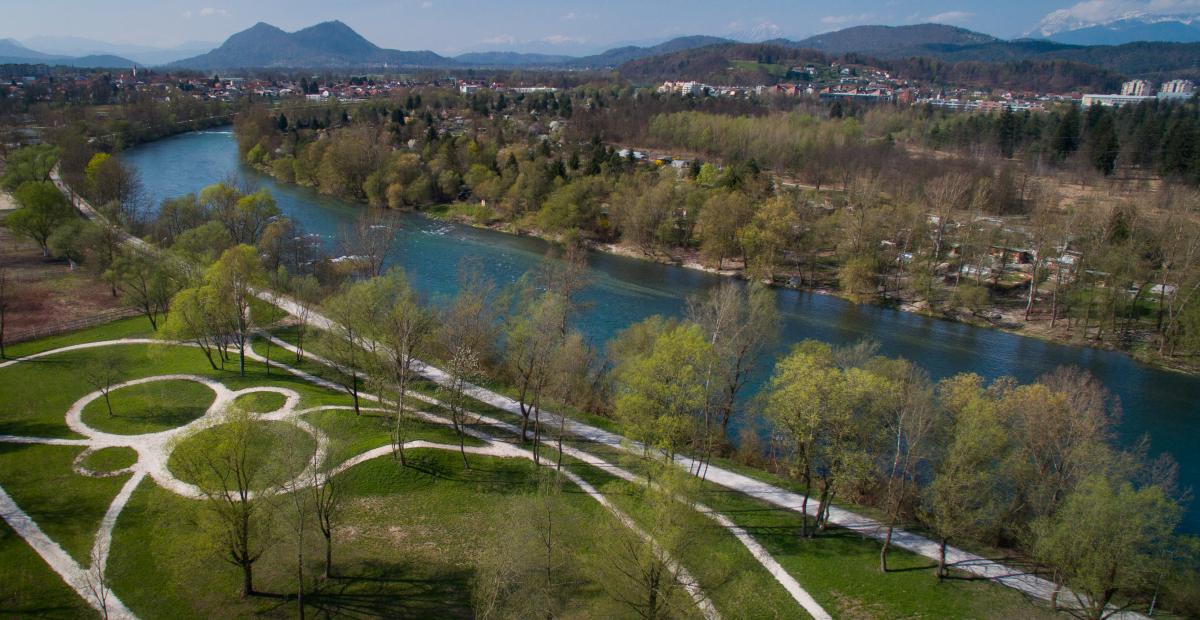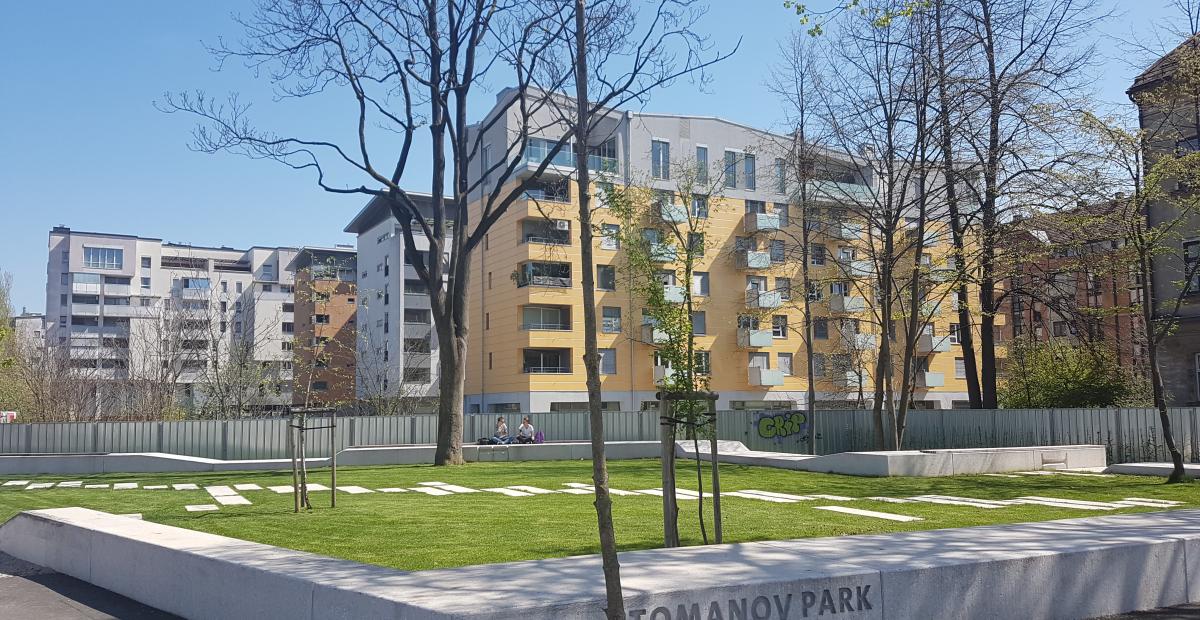
City Park Rakova jelša (surface: 120,000m2). The park area was cleaned, footpaths and a cycling track were constructed connecting the park with the Nature Park Ljubljana Moors and an allée was planted. Photo: Nik Rovan

City Park Rakova jelša with picnic areas and connecting paths to the landscape park Ljubljana Moors as well as a children’s playground, footbridge across the Lahov graben, also featuring gardens and public orchards.

City park Rakova Jelša, footbridge across the Lahov graben, made of burnt wooden beams.

Šmartinski park, once a degraded and illegal area, now a green and peaceful place (surface: 63,984m2). Photo: Dunja Wedam

Šmartinski park with the most modern playground in Europe. Photo: Luka Vidic

In Šmartinski park you can also find a dog park. Photo: Nik Rovan

The Sava River Path, recreational and educational areas along the Sava, run from Tomačevo to Sneberje (for 8 kilometers) (surface: 144,618m2). Photo: STA

Northern City Park with a children’s playground (surface: 18,925m2). In 2017, the survey in the Dnevnik newspaper named it the most beautiful children’s playground in Ljubljana. Photo: Dunja Wedam

On city-owned land that we are arranging and leasing for gardening, we only allow the use of substances used in organic farming. Photo: Dunja Wedam

In 2017, the construction pit was redesigned into the Toman’s Park (surface: 1,100m2). Photo: Nuša Krajnc

In an area of the Park Vodnikova approximately half a hectare in size, we arranged a playing path with ten stations following the principles of forest pedagogics.

Footbridge over Mali graben, photo: Nik Rovan

The Sava beach arrangement project included the rehabilitation of the Sava riverbank, the regulation of water access and the installation of concrete sunbathing platforms. The beach is intended for sunbathing, not swimming. Photo: Helena Regina

Regional Waste Management Centre (RCERO) Ljubljana - the entire project is managed by public company VOKA SNAGA under the authority of the City of Ljubljana and other municipalities. Photo: VOKA SNAGA

In Ljubljana, there are more than 67 underground collecting points, which replaced approximately 9,500 ordinary waste bins. We will continue with the installation of underground collecting points also in the future. Photo: VOKA SNAGA

In the playground in the neighbourhood Savsko naselje and on the hill between the Linhartova, Savska and Mislejeva ulica streets, we planted old local Slovenian varieties of apple and pear trees. Photo: Nik Rovan
More than 100 acres of new green surfaces
Degraded, overlooked and unused areas of the city are being changed into new green surfaces, which contributes to easing the climate change and to a quality leisure time of citizens and visitors of Ljubljana (parks, gardens, playgrounds, urban orchards, etc).
New footbridges on the Path of Remembrance and Comradeship
For even nicer walks and more pleasant leisure times, we have also installed new footbridges on the Path of Remembrance and Comradeship – over the Glinščica river, Pržanec brook and Mali graben canal, which with its 42m of length is one of the longest footbridges made of laminated wood in Europe.
City park Rakova jelša
Approximately 12 hectares of the former gardens at Rakova jelša that became an illegal waste deposit site after the illegal gardens and their sheds were removed in 2010 were completely redesigned and given a new life.
The new design includes a park area with picnic spots, which is also the entry point into the Nature Park Ljubljana Moors, a public orchard with nearly 100 different fruit trees, and a new gardening area with over 300 small gardens. In addition to the gardens, we also provided the infrastructure that is connected to the existing system of paths and ditches.
Vodnikova park
Before the renovation, the park area was an overgrown meadow with a diverse relief, which was often the gathering point of drug addicts. Through its revitalisation, we arranged the access to Vodnikova cesta, installed the playground equipment, arranged the footpaths, and provided access to the playing areas.
Koseze pond park
In 2015, the brownfield area next to the Koseze Pond has been transformed into a multigenerational park (0.15 hectares) with a playground for toddlers and children with playground equipment suitable also for people with disabilities. Also exercise equipment was installed and can be used by elderly citizens for recreation. The revitalisation encompassed the removal of construction waste, purchase and construction of the playground equipment, construction of new footpaths, arrangement of access to the playing areas, as well as planting of trees (a birch groove) and protection shrubs in front of the Draga street.
The system of underground collection points in the city centre
Ljubljana is the first and only zero waste capital in Europe. Four types of waste is collected in Ljubljana through the door-to-door system. In the city centre, we have also provided efficient and more appealing underground waste collection points. Undergroundbins for paper, glass and packaging are accessible to everyone, however the bins for biological and other waste are intended for households and shops, catering facilities and companies. Users open them with special cards that record the entry, which determines the monthly charge.
In Ljubljana, there are 69 locations of underground collecting points, which replaced approximately 9,500 ordinary waste bins. We will continue with the installation of underground collecting points also in the future.
Regional Waste Management Centre Ljubljana (RCERO Ljubljana)
The Ljubljana Waste Management Centre is the largest environmental project in the country, constructed for waste management of almost half of Slovenia. A key part of Regional Centre are three facilities for the mechanical-biological waste processing. The crucial task of the Regional Centre is to extract as many still usable materials from the mixed waste and to produce compost from separately collected biological waste. The latter is of premium quality.
The waste processing factory, which is the unofficial name for the centre, uses the most advanced and sustainable waste management technology according to the European criteria. It also provides green jobs. With a special educational path, public company VOKA SNAGA showcases waste management according to the principles of circular economy in a creative way.
The project already involves 50 municipalities.
The entire investment in RCERO Ljubljana is valued at EUR 155 million. For the project, the European Commission approved EUR 77.6 million (65.88%) from the EU Cohesion Fund. The remaining funds were provided from the national and municipal budgets as well as environmental levies for the environmental pollution due to waste disposal.
Arrangement of gardening areas
The City of Ljubljana strives for an increased level of self-sufficiency since food production on smaller areas is also an extremely important social activity with a strong potential for intergenerational cooperation, increased social inclusion, and a welcome alternative for underprivileged citizens. So far, we have arranged more than 900 small gardens.
Educational garden at Rakova jelša
Equally important as arranging the gardens is also the training of gardeners for the production of vegetables in the areas where gardening is executed in an organic way. Therefore, in 2017, we are arranging an educational vegetable garden in the area of small gardens at Rakova jelša. It is is gradually being arranged on the area of 300 square metres and in accordance with the gardeners’ methods, so that they can learn from practical examples. The educational garden is well visited, the gardeners are making friends with one another and they exchange experiences as well as help each other. All activities in the educational garden are carried out under the leadership of a mentor and at regular weekly meetings. When the weather is suitable, we organise different activities coordinated with the annual gardening calendar.
Public orchards
Within the European Green Capital 2016 project, we opened the first public orchard at Grba. We planted 108 fruit tree saplings and 30 saplings of decorative apple trees. The public orchard was designed as an open space intended for education and leisure. Later on, we also designed public orchards next to the gardens at Rakova jelša, along Vojkova cesta, in the Savsko naselje neighbourhood, and along the Muste Family Park.
Urban orchard and the renovation of the playground in the neighbourhood Savsko naselje
The arrangement of the urban orchard (100m2) and the renovation of the children’s playground between the streets Linhartova, Savska and Mislejeva ulica are all part of a more extensive project to revive the neighbourhood Savsko naselje. The renovation and revival of the area around Savski hrib, including a basketball court and a children’s playground, the hill above the bomb shelter, and some lawns were redesigned upon a citizen’s initiative. During the renovation, we preserved the original playground equipment, repainted them to give them a uniform look, and upgraded the ground with a few additions. A real urban orchard was also created in the Savsko naselje neighbourhood.
Forest classroom for the blind and visually pmpaired in Park Tivoli
In Park Tivoli, a forest classroom for the blind and visually impaired has been arranged. The classroom features an access path, a sand platform and a wooden terrace, and is enclosed by a wooden fence on three sides. The design of the classroom allows us to get to know its elements by moving along its perimeter. The goal of the forest classroom is to learn the differences between natural parks and natural monuments as well as landscaped nature (city parks), and to familiarize ourselves with the most common deciduous trees growing in our forests.
The revitalisation of the Tivoli pond
The revitalisation and thus the increase of the biodiversity comprised the arrangement of the east bank of the pond planted with common reed and the construction of the two moor beds next to the concrete barrier. We also redesigned the inlet and outlet of the pond as well as constructed two wooden platforms where visitors of the pond like to sit down.
Ljubljana shelter for abandoned animals
Ljubljana Shelter for Abandoned Animals is the largest shelter in Slovenia and was among one of the first shelters in the country. A quarter of abandoned animals in Slovenia has found safety here. We pride ourselves on our enormous professional progress: animals are taken care of in accordance with the highest professional protocols for animal shelters in Slovenia, which are among the most advanced in the world. Furthermore, we do not put animals down when they require a longer stay. The biggest improvement in recent years has, among others, been the beginning of professional socialisation and rehabilitation of unwanted behaviour of dogs and professional training of the shelter’s volunteers – dog walkers. We first and foremost give dogs an opportunity to be re-homed and additionally promote the general trend of schooling and training dogs. We also aim to increase the owners’ responsibility towards animals.
Sava beach
In Ljubljana, at the Sava River, we set up the Sava beach. The beach is located in the Natura 2000 area, natural values area of the Sava River and ecologically significant area, where land development is very restricted, that is why the set-up was confined to restoring the bank, providing access to the water and constructing concrete platforms for sunbathing. Access for emergency services (firefighters) was also provided, as there was none. The beach is intended for sunbathing, not swimming.
Muste family park
Between Nove Fužine and Štepanjsko naselje the Muste family park opened in 2018, and is considered one of the larger green acquisitions in Ljubljana. The conceptual design was prepared in 2015 and its set-up started in 2017. Among other things the park includes a playground with play equipment for children of all age groups, appropriate also for movement impaired children. On the north side of the park an urban orchard is set up, already the fourth in Ljubljana. It has 64 fruit trees, namely, old varieties of apple, pear, quince and plum trees and the fruit growing on the trees is intended for all park visitors. In addition, in its vicinity there are 14 park trees planted in a row. Within the scope of the park there is also a parking area for the needs of the movement impaired people with a path connecting it to the park.

Renovated embankment of the Ljubljanica river in the Muste park
Within the framework of the comprehensive set-up of the Muste Park, after opening the family park in spring 2018 we have opened the new renovated left embankment of the Ljubljanica River in the end of 2018. We have cleaned up the area, removed the waste, cut the vegetation, planted the hedges, constructed a walking path and installed urban equipment. On the gravel part of the embankment we have designed a beach where we have set up concreate sunbathing surfaces. We have also planted the missing trees in the avenue and a lawn.
The student park in front of the Bežigrad grammar school
The students of the Bežigrad grammar school provided the incentive for the development of the park. The installation of water and the placement of a water fountain has been arranged, as well as the trimming of trees and bushes, pathways have been created and urban furniture (benches and chess tables) has been placed. We have also formed a small green surface where students of the Bežigrad grammar school and nearby residents and visitors will be able to spend time together in the shade.

Toman's park
In 2017, the construction pit in the city centre near the railway station was redesigned into the Toman’s park.
Terrain park
The park was named Terrain as it represents an area for experimenting, constructing and testing new ideas with different stakeholders, and it is based on the idea of promoting circular economy.
The construction pit has been temporarily transformed into an urban culture construction site. The Terrain offers new opportunities for learning, socialising, discovering and playing. Current project participants are: the Waldorf School (designing garden beds in line with the re-use principle to grow different vegetables), the Universal Atelier of Street Art and the Sports and Cultural Association GOR (they made benches and outdoor workout equipment, they refurbished an old kiosk into a shed for storing tools, and from spring 2018 onwards break dance and graffiti workshops are also going to be held here), the Rainbow Warriors Society (offering play therapy on the site), the Abandoned Plants Sanctuary (they are making a greenhouse where plants can be picked up or brought to and they are also organising workshops on the topic), and the ProstoRož Association (coordinating users and presenting gardening inventions).
All equipment is made out of waste items and materials found in the collection centre run by the public company VOKA SNAGA.
The project has two main goals:
- active inclusion of different stakeholders – especially the young (NGOs, associations, schoolchildren, companies, citizens…),
- practical presentation of the significance of circular economy.
Urban forest
We have developed an urban forest in the area around the Teren adventure park on Masarykova road. Immediately next to the Teren park, where an illegal car park had begun to develop, we placed 500 litre troughs and planted 19 different sorts of maple trees. This development not only prevents illegal parking, but also directly influences the mitigation of climate change. It is a temporary development which will continue until the start of the planned construction in this area.
Livada
Together with our youth we have transformed an abandoned area into a real teaching laboratory, which was also the aim of the international project Green Surge, the framework within which LIVADA was developed. The aim of the project was to create, in cooperation with relevant stakeholders, a model of innovative planning and introducing multi-purpose green city infrastructure. The result of the Green Surge project is the urban community space LIVADA enabling: planning, establishing and using a space tailored to its users; space for the youth for active spending of free-time with green economy features; joint socialising space for the planned Youth Centres Network Ljubljana; development of a healthy urban living area, local production of quality food and promotion of biocultural diversity of an urban area.



